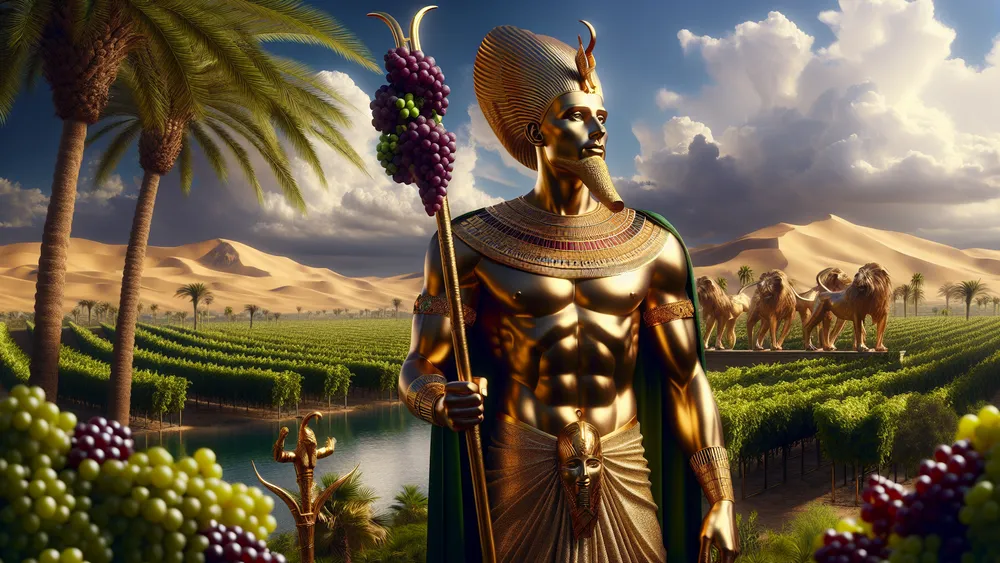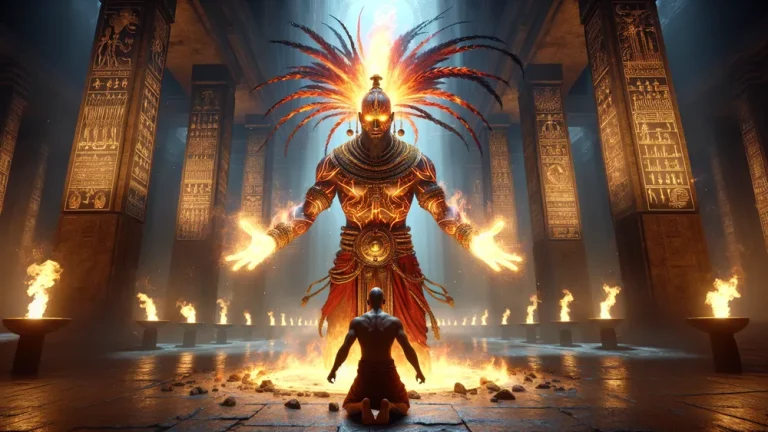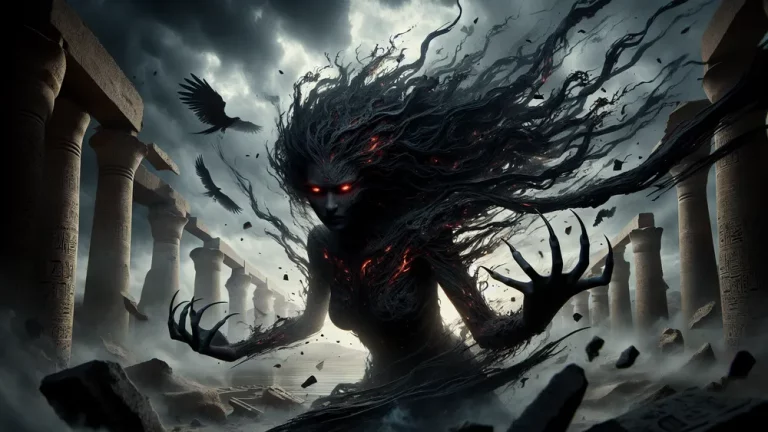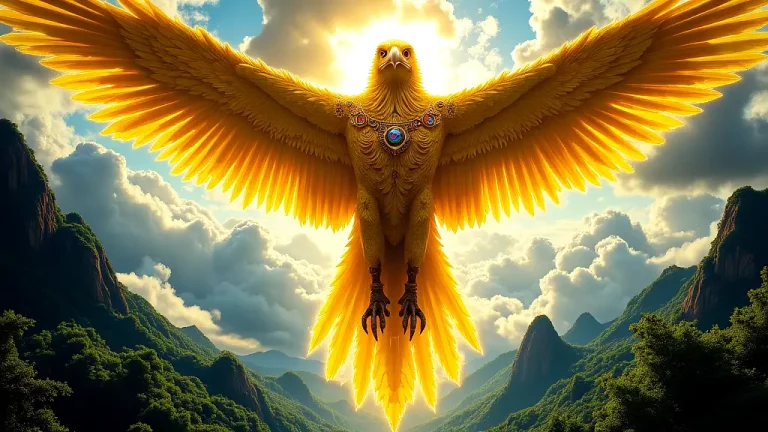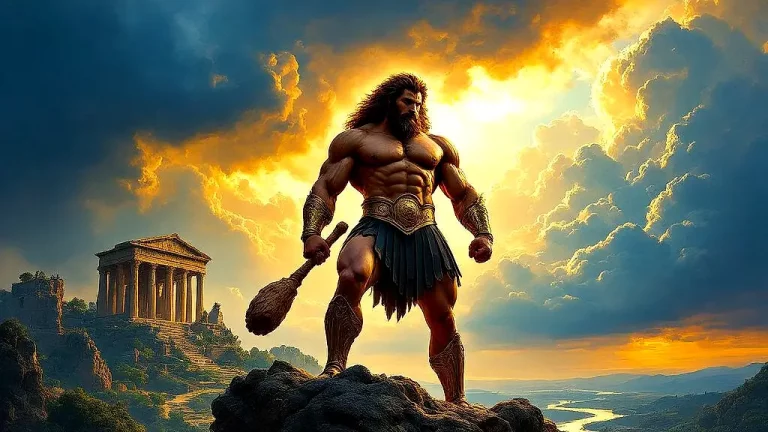Ash: Egyptian God Of Oases And Vineyards
Imagine walking through the big, dry areas of the old Egyptian desert, where seeing a green oasis would feel amazing. Like how people today depend on needed things like water and food, the ancient Egyptians needed these green spots to stay alive. The center of these important places was Ash, the god who looked after oases and grape gardens.
Key Points:
- Ash was the ancient Egyptian god of oases and vineyards.
- He was worshipped during the Old and Middle Kingdom periods.
- Ash was vital for the fertility and growth of desert communities.
- Offerings to Ash included water, wine, and farm produce.
- Ash’s influence extended to nearby cultures like Nubia and the Levant.
- His legacy is evident in modern scholarly research and popular culture.
This text will look at the interesting life of Ash, checking his beginnings, his part in old Egyptian life, and how he affected both oases and grape places. We’ll travel through old times, old writings, and items to discover how Ash was honored and shown. We’ll also look at the rituals and offerings given to Ash, his important meaning, and how he’s seen today in Egyptian stories.
By finishing this look, you’ll get a good idea of Ash’s importance and his lasting effect on his worship.
Ash: Overview and Key Facts
| Key Point | Description |
|---|---|
| Name | Ash (sometimes As or Aash) |
| Role | God of Oases and Grape Gardens |
| Symbolism | Growth, wealth, and energy |
| Depictions | Shown as a human shape with a special hat |
| Historical Period | Mainly worshipped during Old and Middle Kingdom |
| Regions of Worship | Mostly in Western Desert and oasis places |
| Cultural Significance | Important for the life and growth of desert people |
| Associated Symbols | Oasis, grapevine, and sometimes a stick or rod |
| Rituals and Offerings | Give water, wine, and farm produce for growth |
| Legacy | Affected nearby cultures and is still interesting in modern views of Egyptian stories |
Where Ash Came From and Why He’s Important
To really grasp Ash’s value, we should look into where he came from and the old times when he was honored. Now, we’ll check out the long history and the big deal Ash was in old Egyptian life.
A Look Back at Ash’s History
Ash was mostly honored during the Old Kingdom (around 2686–2181 BCE) and Middle Kingdom (around 2055–1650 BCE) times of old Egypt, with people worshiping him primarily in the Western Desert and the oasis places. These spots were super important for the life of desert groups, just like how we need basic things today.
Ash’s importance in old Egyptian life and religion came from how he was the keeper and giver of these life-saving oases and good vineyards. For the Egyptians back then, Ash wasn’t only a god but a necessary power making sure they thrived and stayed healthy. People did many rituals and gave gifts to keep him happy and to keep the land growing well. Key things about Ash’s historical setting include:

- Time Periods: Old Kingdom and Middle Kingdom
- Regions: Western Desert and oasis places
- Cultural Importance: Making sure fertility and growth of oases and vineyards
Ash was a crucial deity in ancient Egyptian life, particularly during the Old Kingdom and Middle Kingdom periods, overseeing the fertility and growth of oases and vineyards in the Western Desert and oasis regions.
Ash in Old Egyptian Writings and Artifacts
Ash shows up in different old Egyptian texts, like symbols and old papers, which give important details about his part and importance. For example, symbols found in temple writings often show Ash as a guardian of oases, showing his key role in making sure these important areas stay fruitful and rich.
Old papers, used as records, sometimes talk about Ash with farm rituals and gifts, showing his link to the land’s output. These texts are like today’s records, keeping the beliefs and actions of old Egyptians for future people to learn from.
Also, many objects and pictures of Ash have been found in dig sites. These include statues, carvings, and writings that show Ash with special looks, like a hat showing his godly rank. For instance, statues of Ash usually show him holding a stick or rod, showing his power over oases and vineyards.
Carvings found on temple walls often show Ash in scenes of farm plenty, reinforcing his image with growth and wealth. Key things related to Ash include:

- Statues: Often show Ash with a stick or rod
- Carvings: Show Ash in scenes of farm plenty
- Writings: Highlight his part as a guardian of oases and vineyards
Ash as the God of Oases
Now that we looked at Ash’s historical setting and pictures, next, we will talk about his big role as the god of oases. This part will look at how Ash affected the growth and wealth of these key places.
How Ash Helped Oases Grow
People thought Ash was the godly power behind the growth and good things in oases, making sure these key places did well in the tough desert. Much like modern water systems give water to help plants, Ash was believed to bring life-giving water and green plants to the oases, making them lush and liveable. His power was seen as crucial for the growth of plants and the health of the people depending on these fertile spots. To show the historical importance of different oases linked with Ash, here is a comparison:
| Oasis | Historical Importance |
|---|---|
| Siwa Oasis | Known for its rich farming land and the famous Oracle of Amon, visited by Alexander the Great. |
| Kharga Oasis | Was a big trade route and a center for growing dates and other crops. |
| Dakhla Oasis | Had very old settlements and temples, showing its long-standing importance in Egyptian history. |
| Bahariya Oasis | Famous for its wine-making and as a source of iron ore, helping Egypt’s economy. |
Acts and Gifts for Ash in Oasis Areas
To make sure the oases stayed well and good, ancient Egyptians did different acts and gave gifts to Ash, the god of these fertile places. These gifts often had food, drink, and symbol things like little statues or charms, which were believed to make Ash happy and get his good wishes.
Much like how we might have a big meal to celebrate a good harvest, they held festivals and events made just for Ash. One such festival was the “Feast of Ash.” They celebrated it in the oases with group gatherings, music, and dances to honor the god and thank him for the growth he brought to their lands.
These acts of devotion were very important to keep the oases growing well and staying rich, making sure they remained safe places for life in the desert.
Ash as the God of Vineyards
After we looked at Ash’s important job in looking after oases, now we will talk about his power over vineyards and how wine was grown in ancient Egypt.
What Vineyards Meant to the Ancient Egyptians
In old Egyptian culture, vineyards meant a lot, showing life, plenty, and godly favor. Much like how we might see a full orchard as a sign of good times, the Egyptians saw vineyards as proof of the land’s growth and the gods’ blessings. Vineyards gave not only food and drink but were also key to their religious and social get-togethers. They were linked with:
- Wealth: Vineyards showed wealth and money safety, giving useful things like wine.
- Growth: The growing of vineyards showed the land’s growth and the gods’ favor like Ash.
- Festivity: Wine from vineyards was central to many events and other gatherings, meaning joy and group happiness.
These links made vineyards an important part of both the spiritual and everyday lives of the old Egyptians.
How Ash Influenced Wine-Making
People thought Ash had a big role in keeping vineyards safe and making sure they grew well, and the vines stayed good and useful. Just like today’s farmers use various ways and tools to keep their crops safe, long ago, Egyptian vineyard folks did special acts to honor Ash and get his good wishes.
These acts had giving the first fruits of the harvest and pouring out wine at the bottom of the vines, which meant feeding the plants with the god’s favor. They believed calling for Ash’s help would make their vineyards grow well, giving plenty of good grapes for wine-making.

This godly help was seen as very necessary for keeping the vineyards rich and full of life, making Ash a very important figure in the farming life of old Egypt.
Ash was seen as crucial for the success of vineyards in ancient Egypt, with people performing specific rituals to seek his blessings for healthy crops and abundant harvests.
Ash’s Depictions and Symbols
Since we have talked about Ash’s effect on vineyards and making wine, let’s look at how this god was shown in old Egyptian art and the signs used with him.
What Ash Looked Like in Egyptian Art
In very old Egyptian art, Ash had signs that showed he was special and had important jobs. Often, they made him look like a person with an animal head from the desert, such as a lion or a bird of prey, showing he ruled dry places and could protect. And he had items like the scepter and ankh a lot, which stood for power and forever life.
These items were not just picked for fun but showed deep ideas; for example, the scepter meant he had control over places with water and vineyards, while the ankh showed he gave life to these rich areas.
Like modern symbols such as a crown or shield mean being a leader and protecting, Ash’s signs showed his key traits to ancient Egyptians, making his looks well-known and deeply special.
How Ash’s Images Compare with Other Gods
Looking at Ash’s pictures next to other Egyptian gods, some clear differences and similarities come up. Horus and Ra usually have falcon heads to show they rule the sky, but Ash has an animal head from the dry lands, such as a lion or a hawk, showing he is linked to dry regions and water spots.
Also, Osiris is often shown with a crook and flail, which mean kingship and growing crops, while Ash has a scepter and ankh that stand for his control over water spots and vineyards and his life-bringing power. These comparisons show how each god’s look was made to fit their specific areas and jobs within the group of gods.
But what makes Ash different from other gods is the special mix of signs that tie him to both the dry and green areas, a mix not seen much in other gods.

Having the head of a desert animal shows his role in guarding the tough, dry places, while the scepter and ankh show his power over the green, life-giving water spots and vineyards. This mix of signs made Ash stand out in Egyptian myths, showing both the hard and life-giving sides of the desert.
Like how today’s logos quickly show a brand’s identity and meanings, Ash’s special look told his many sides to the old Egyptians, which made him easy to know and deep in their respect.
Ash’s Influence Beyond Egypt
Since we have looked at Ash’s special looks and signs, it’s time to see how his power spread past the boundaries of ancient Egypt.
Ash in Nearby Cultures
Ash’s reach did not stop at the edges of ancient Egypt; it spread into close areas like Nubia and the Levant. In Nubia, for example, Ash was often mixed with local gods, combining traits to make a new form that both Egyptian and Nubian people could connect with.

This mixing of cultures is like how today, globalization allows mixing of traditions and ways of life in different places. Also, in the Levant, parts of Ash’s worship were taken into local beliefs, showing a free exchange of ideas and beliefs.
These examples of mixing show how Ash’s traits as a god of oases and vineyards were flexible and powerful, letting his worship go beyond borders and blend into the ways of nearby areas.
How People See Ash Today
Nowadays, people look at Ash through scholarly research and popular culture. Researchers still study his role and importance, showing his special traits and impact. Meanwhile, you can find Ash’s legacy in things like documentaries, books, and even video games that look at old Egyptian themes.
Similar to how movies and books show historical figures in new ways, Ash’s stories and pictures are changed for modern times, making him easy to understand for people today. Just as Cleopatra is often shown in films and books, Ash’s image and myths are adapted to modern stories, making him clear to today’s audience.
These new versions help keep Ash’s memory alive, letting people understand his role in old Egypt and see him in fresh and interesting ways.

Pantheon of Egyptian Mythology Gods
The group of Egyptian gods is big and complex, with many different gods and goddesses, each having their own special traits and stories.
From well-known gods like Ra, the sun god, to less-known ones like Ash, the god of oases and vineyards, the Egyptian group of gods is like a large cast of people in a book, each playing an important part in the story of ancient Egyptian life.
For anyone wanting to see the full list of these interesting gods, you can find a complete list of all the Egyptian gods. This page gives detailed facts on each god, offering a deeper look at their roles and importance in the stories.
FAQs
1. Who was Ash in ancient Egyptian mythology?
Ash in ancient Egyptian mythology was the god of oases and vineyards, symbolizing fertility and prosperity in these regions.
2. What were the main symbols associated with Ash?
The main symbols associated with Ash include the desert, oases, and vineyards, reflecting his domains of influence.
3. How did ancient Egyptians worship Ash?
Ancient Egyptians worshipped Ash through rituals, offerings, and ceremonies dedicated to ensuring the fertility and prosperity of oases and vineyards.
4. What is the legacy of Ash in modern culture?
The legacy of Ash in modern culture is primarily seen through his representation in contemporary media and scholarly interpretations of ancient Egyptian mythology.

